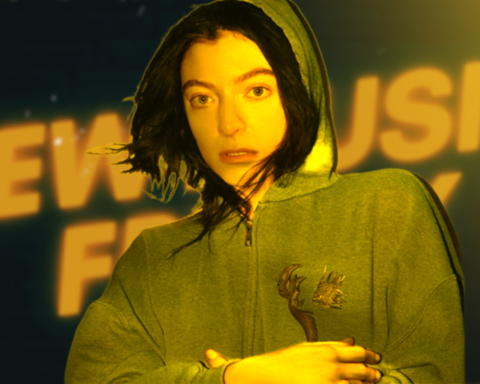On a chilly evening in mid-September, painter Marc Dennis was dining at Le Gratin, Daniel Boulud’s tony new downtown Lyonnais restaurant next to the Beekman Hotel. It was only 7 pm, but the restaurant was busy with a mix of large groups on their third martini and couples on first dates. On the walls around the diners hung three paintings Dennis loaned to Boulud specifically for Le Gratin, which opened last year: five-foot-tall realistic floral still lifes in the genre of memento mori, a reminder that death is never far away. A staple of art since the Renaissance, the genre is a favorite of Dennis’s. He’s explored the theme in still lifes of decapitated birds, dead animals procured straight from his local butcher in New Jersey, and remnants of a nefarious night out: a bedside table bearing a 9mm Smith & Wesson, bunched-up undergarments, and jewelry. But these paintings, depicting bouquets in various stages of decay, caught Boulud’s eye and have been in the restaurant since opening night. The paintings are, however, missing a detail that Dennis had originally thrown in. Laying on a thick French accent, he imitated his celebrity client. “Marc, can you please remove the beetles, would it be a trouble?” “Of course. How about snails?” “Oui!”
An affable, divorced, 50-year-old father of two who lives in suburban New Jersey, Dennis was wearing a blue blazer and gingham dress shirt, and multiple metal rings and beaded bracelets. His short goatee gives him more than a passing resemblance to Johnny Depp. “My daughters’ friends all call me Johnny. Or Jack Sparrow.” For close to two decades, he has made hyperrealistic paintings partly on a commission basis, but the difference between him and your local dog portraitist is that his clients—who also buy his noncommissioned work—sit at the pinnacle of the contemporary art world. This puts him in a strange position in a milieu known for its snootiness: he is at once on the margins of the global art scene and at its red-hot center. When I told one art world insider I was writing about Dennis, he dismissed him with a single phrase: “He sucks up to collectors.” Dennis’s thriving career runs in direct contradiction to the art world’s distaste for those who hustle to promote themselves.
“Marc has always been a strong advocate for himself,” Glenn Fuhrman told me as he reached for the memory of how he first met Dennis. A MoMA trustee, Fuhrman has spent almost 20 years on the ARTnews Top 200 Collectors list, and owns pieces by the likes of Brice Marden, Juan Muñoz, Maurizio Cattelan, and Katharina Fritsch. “I saw his work in a gallery, it must have been 15 years ago, back when I was single. I thought it was pretty amazing.” It was then that Fuhrman bought the first of the eight Dennis works he owns, Art History Major, which features a girl flashing the viewer while standing in the Sistine Chapel, a pleased smirk on her face.
Dennis’s work from the late aughts to his work today: a masterful realistic style, a reverence for the old masters, and a piquant sense of humor. It’s that combination perhaps that may have unnerved New York dealers over the years. At a glance, his work comes off as pure kitsch, bordering on camp, without the midcentury allure that makes a Warhol or a Lichtenstein so valuable. It’s not hard to imagine a dealer avoiding an artist like Dennis a decade or more ago when figurative work in such a hyperrealist style wasn’t as popular as it is today.
“He’s so technically gifted, a real master, that to some extent I think contemporary galleries viewed his work as overly academic,” Fuhrman said. “But a lot of his work transcends his style. It’s not just about photorealism. There’s much more to see and think about and discuss than how technically gifted he is.”
Dennis’s benefactors tend to talk as much about him as a person as they do about his art. Beth Rudin DeWoody, a major philanthropist and longtime Top 200 Collector, is taken with the fact that he is the director and head instructor of a career development program at the Art Students League, that he’s taught Holocaust studies as a tenured professor at Elmira College and has lectured at Cornell, and that, as a teenager, he lived on the Pine Ridge Indian reservation in South Dakota and learned the Lakota language spoken by the Sioux tribes.
Recently, Dennis has made a dramatic turn toward what he freely refers to as identity art. His latest show, Three Jews Walk into a Bar, is on view at A Hug From The Art World, a gallery started by former Gagosian gallery director (and now consultant to the gallery giant), Adam Cohen. It considers Judaism in a way few, if any, painters have done before. Each painting portrays a group of three Hasidic Jews looking at Edouard Manet’s last great work, the 1882 painting A Bar at the Folies-Bergère. In one, the men are wearing stylish Burberry jackets. In another, they are holding plastic bags that make it look as if they’ve just come from the bakery. (Flour, or perhaps powdered sugar, looks to be rubbed into one of the men’s long black coats.) Dennis gets a laugh out of a deeply religious image, mixing levity and piety in a way that both draws viewers in and makes them uncomfortable. Genuinely personal details include the lavish wallpaper behind one Manet painting, a re-creation of that from a grandparent’s home; on his mother’s side, Nana and Papi, and on his father’s, Bubbee and Zaydee. (Dennis can trace the lineage of his father’s family, the Kohens, back to Aaron, brother of the Biblical prophet Moses.) It all has roots in the artist’s past: Hasidic Judaism is a product of 18th-century western Ukraine, the home of Dennis’s Ashkenazi ancestors.






